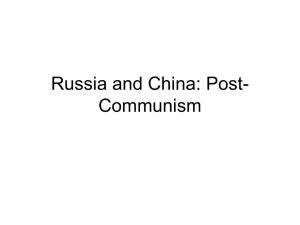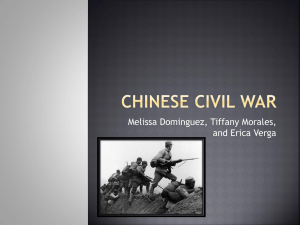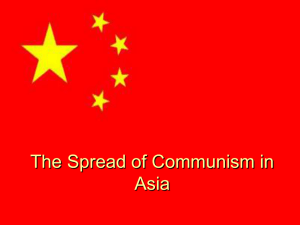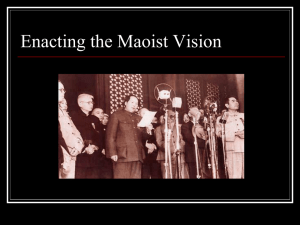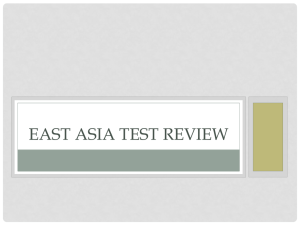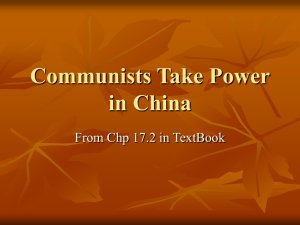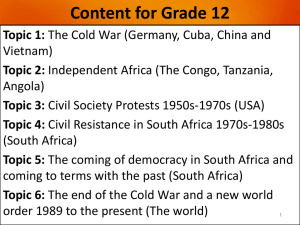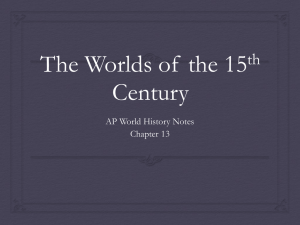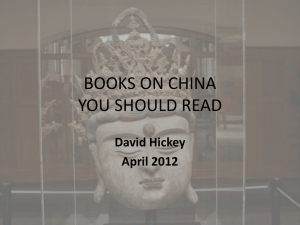Politics in China
advertisement
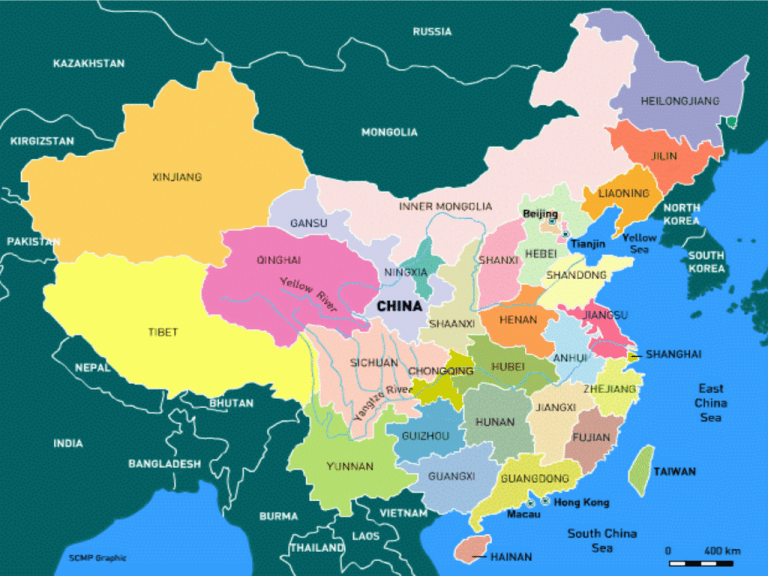
1 of 67 Historical Setting: Imperial Era • As a polity, imperial China was the longest-lived major system of governance in world history, enduring as a centralized state ruled with little change in political philosophy or bureaucratic organization for more than two millennia until the fall of the Qing, the last dynasty, in 1911. 2 of 67 Historical Setting: Confucianism • Confucianism was basically a conservative philosophy. • It conceived of society and the polity in terms of an ordered hierarchy of harmonious relationships. • Loyalty to the emperor was the highest principle in the hierarchy of relationships entailing mutual obligations throughout society. 3 of 67 Nationalists and Communists • By the 1920s, the Nationalist Party and army had emerged as the most prominent political and military force in the country. • By contrast with the Nationalists, the intellectual revolutionaries who founded the Chinese Communist Party in 1921 were unlikely contenders for power. 4 of 67 The People’s Republic of China • The history of the People’s Republic of China (PRC) can be divided into three major periods. • In the first, between 1949 and 1957, the Chinese adopted a “lean to one side” strategy, emulating the experience of the first and most powerful communist state, the Soviet Union. 5 of 67 Hundred Flowers Campaign • Communist leaders were sufficiently confident about the results of political education and regime accomplishments to invite nonparty intellectuals to voice criticism in the Hundred Flowers Campaign in 1957. • When criticism was harsh, revealing weak support for the communist system, the leaders quickly reversed themselves. 6 of 67 The People’s Republic of China • The second period began in 1958, when the Chinese introduced their own model of revolutionary development. • Except for a few years at the beginning of the 1960s, this Maoist model prevailed until Mao’s death in 1976. 7 of 67 The Great Leap Forward • In 1958, Mao proposed a strategy of simultaneous development of industry and agriculture. • The Maoist model was not simply an economic development strategy. • It was fundamentally a political campaign, a point exemplified in the main slogan of the Great Leap Forward: “politics in command.” 8 of 67 The Cultural Revolution • In 1966, Mao argued that many communist leaders were corrupt “capitalist roaders” who opposed socialism and must be thrown out of power. • He launched the Great Proletarian Cultural Revolution, yet another exercise in radical excess. 9 of 67 The Cultural Revolution • The Cultural Revolution was simultaneously a power struggle, an ideological battle, and a mass campaign to transform culture. • Compared with the Great Leap Forward, its impact on the Chinese economy was minor; its impact on society was devastating. 10 of 67 The People’s Republic of China • A short transitional period ensued, during which immediate problems of policy orientation and leadership succession were resolved with the arrest and trial of key radical leaders. 11 of 67 The People’s Republic of China • In December 1978, the third period, a new era of reform, ongoing today, was inaugurated with a Central Committee declaration favoring learning from practical experience and rejecting the ideological constraints of Maoism, or any theory. 12 of 67 Social Conditions: Population • This section focuses on basic features that make up the social environment for Chinese politics that have not undergone fundamental transformation but have changed only in degree, if at all. • First among these is China’s huge population. 13 of 67 Social Conditions: Arable Land • The second basic feature involves geography. • Despite efforts to preserve arable land for farming, China’s leaders have been unable to reverse the reduction in cultivated area. 14 of 67 Social Conditions: Minorities • The third feature is that China is a multiethnic state. • Although minorities make up only a fairly small proportion of China’s population, areas in which minorities live comprise more than 60 percent of China’s territory, and much of this is in strategically important border regions. 15 of 67 Structure of the Party-State • From top to bottom, Chinese politics has changed noticeably since the Maoist period. • Yet, the essential form of the Chinese political system retains an organizational design borrowed decades ago from the Soviet Union and developed nearly a century ago in Russia by Lenin - the design of the communist party-state. 16 of 67 Design Features: Lenin • According to Lenin, as ordinary citizens typically lack revolutionary consciousness and knowledge of communist theory, they are incapable of making the correct choices that will lead from capitalism to socialism and toward communism. • Lenin proposed a solution to this problem: a political party and political system built on the principles of guardianship and hierarchy. 17 of 67 Design Features: Mass Line • To these two principles, Chinese leaders added the idea of the mass line, formulated by Mao in the 1940s. • Guardianship and hierarchy define the communist party-state. • The mass line adds another dimension, which moderates guardianship. 18 of 67 Design Features: Mass Line • Chinese Communist Party guardianship is, in theory, informed by the practice of the mass line. • The party leads, but its leadership is not isolated from the opinions and preferences of the mass public. 19 of 67 Design Features: Mass Line • Party leaders at all levels (but especially at the grassroots) are supposed to maintain a close relationship with ordinary citizens so that the party organization can transform the “scattered and unsystematic ideas” of the masses into “correct ideas” and propagate them “until the masses embrace them as their own.” 20 of 67 Design Features: Mass Line • In this way, policy is supposed to flow “from the masses to the masses.” • The degree to which mass preferences actually find expression in public policy depends on their fit with larger goals determined by party leaders. 21 of 67 Two Organizational Hierarchies • The internal organization of the Communist Party is organized around a hierarchy of party congresses and committees extending from the top of the system down to the grassroots. • The design of the communist party-state is perhaps most evident in the organization of power in two hierarchies of political structures. 22 of 67 23 of 67 The Government Structures • At the political center in Beijing, the key government structures are the National People’s Congress (NPC), which is China’s legislature, and the State Council, which exercises executive functions. • Under the State Council are government ministries and commissions, which have ranged in number since 1949. 24 of 67 National People’s Congress • According to the constitution, the highest organization of state authority is the NPC. • The NPC and its permanent body, the NPC Standing Committee, exercise legislative functions. • NPC delegates are elected for five-year terms by delegates in provincial-level congresses and the armed forces. 25 of 67 National People’s Congress • Normally, NPC delegates assemble once annually for a plenary session of about two weeks. • Formally, the NPC has extensive powers, including amendment of the constitution, passage and amendment of legislation, approval of economic plans and government work reports, and appointment of top state and government leaders. 26 of 67 National People’s Congress • Is the NPC (and its Standing Committee) a “rubber stamp” assembly? • For the Maoist years, the answer is clearly “yes.” 27 of 67 National People’s Congress • In recent decades, however, the NPC has become more assertive, and its Standing Committee has assumed a greater role in law making. • Actual failure to pass legislation submitted to the NPC has occurred twice. 28 of 67 The State Council • In lawmaking, the State Council is the center of government activity, although this role too is newly enhanced. • The State Council is composed of the premier, who is head of government, and his cabinet of vice-premiers, state councillors, ministers, auditor general, and secretary general (all formally nominated by the premier and appointed by the NPC). 29 of 67 The State Council • As in parliamentary systems, the bulk of legislation is drafted by specialized ministries and commissions under the direction of the cabinet. 30 of 67 The State Council • Also, however, as most Chinese laws are drafted in general and imprecise language, they require detailed “implementing regulations” to have any effect. • These regulations are typically drafted by State Council ministries. 31 of 67 Communist Party Leadership • The Communist Party exercises direct leadership over government and legislative functions in a variety of ways. • As to lawmaking, Communist Party leaders have veto power over all legislation of consequence. 32 of 67 Communist Party Leadership • In short, the Chinese system is executiveled government, but with an important difference having to do with the role of the Communist Party. 33 of 67 Head of State & Head of Party • The president of the PRC is head of state. • This is a purely ceremonial office, held by Hu Jintao. • Hu is also head of the Communist Party organization and of the Central Military Commission, in which leadership of military forces is formally vested. 34 of 67 Judiciary • Judicial authority rests with the Supreme People’s Court at the center and with local people’s courts below. • Formally, the Supreme People’s Court is responsible to the NPC. • Courts at lower levels are responsible to the people’s congresses at their respective levels and also take direction from courts above them. 35 of 67 The Party Structures • At the political center in Beijing, the key party structures are the National Party Congress and its Central Committee, the Politburo, and the Politburo Standing Committee. • Below the center, down to the township level, are local party congresses and local party committees. 36 of 67 The National Party Congress • As in the government hierarchy, while the formal power of Communist Party structures is directly proportional to size, actual impact on policy is inversely proportional to size. 37 of 67 The National Party Congress • The Communist Party constitution vests supreme authority in the National Party Congress, but this structure is too big and meets too infrequently to play a significant role in political decision-making. 38 of 67 The National Party Congress • National Party Congress sessions are short, about a week or two at most. • A main function is to ratify important changes in broad policy orientation already decided by more important smaller party structures. 39 of 67 The National Party Congress • A second function of the National Party Congress is to elect the Central Committee, which exercises the powers of the congress between sessions. • Official candidates for Central Committee membership are determined by the Politburo before the congress meets. 40 of 67 The Central Committee • The Central Committee is the Chinese political elite, broadly defined: • it is a collection of the most powerful several hundred political leaders in the country. 41 of 67 The Central Committee • All Central Committee members hold some major substantive position of leadership, as ministers in the central state bureaucracy or provincial party leaders, for example. 42 of 67 The Central Committee • The Central Committee elects the Politburo, the Politburo Standing Committee, and the party general secretary, all of whom are also Central Committee members. • These leaders are at the very apex of the political system. 43 of 67 Succession Crisis • Members of the Politburo and its Standing Committee are the core political decisionmakers in China, presiding over a process that concentrates great power at the top. • In communist systems, the death of the top leader creates a succession crisis: 44 of 67 Succession Crisis • there is no formal or generally acknowledged position of second-incommand and no regularized mechanism to choose a new top leader. • Mao’s death ushered in a power struggle at the top, won by Deng and his fellow modernizers. 45 of 67 46 of 67 Political Participation • An important aspect of political reform undertaken after Mao’s death in 1976 has been the redefinition of what constitutes “officially acceptable” political participation in the Chinese system. 47 of 67 Political Participation • Guidelines for the new political participation are evident in three categories of rule changes that have routinized participation and reduced its burden for ordinary Chinese. 48 of 67 Political Participation • The changes reflect an official reaction against the disruption that characterized mass participation in the Maoist years (especially during the Cultural Revolution), an official assumption that economic growth is predicated on order and stability, and an official recognition that changes in economic relationships require adjustments in political relationships. 49 of 67 Political Participation • The first category of rule changes involves political participation, which has become essentially optional for ordinary Chinese since the early 1980s. • In the first thirty years of communist rule, for a broad range of political activities, failure to participate was considered tantamount to opposition to the communist regime. 50 of 67 Political Participation • Today, politics intrudes far less in the lives of ordinary Chinese. • The scope and demands of politics have shrunk. • Not only does politics no longer dominate daily life, but in the diminished sphere of political activities, political apathy is no longer risky for ordinary Chinese. 51 of 67 Political Participation • The single most important measure signifying this change is the official removal, in 1979, of all class and political labels. • After thirty years, the Chinese are no longer formally identified by class background or past “political mistakes.” 52 of 67 Political Participation • The second category has been the assiduous avoidance by the regime of rousing the mass public to realize policy objectives. • In the Maoist years, by contrast, the quintessential form of political participation was the mass mobilization campaign. 53 of 67 Political Participation • Mass mobilization campaign: intensive, large-scale, disruptive group action, implemented by grassroots leaders. • The Great Leap Forward launched in 1958 and the Cultural Revolution launched in 1966 were essentially mass campaigns, on a gargantuan scale. 54 of 67 Political Participation • Typically in mass campaigns, grassroots party leaders, responding to signals from the political center, roused ordinary Chinese to achieve regime goals of various sorts, often aimed at identified categories of enemies. • Participation in campaigns was virtually compulsory. 55 of 67 Political Participation • Only three years after Mao’s death, Chinese leaders issued an official rejection of mass campaigns as a mode of political participation. • The social disorder of campaigns was rejected as antithetical to the new priority of economic growth. 56 of 67 Political Participation • The third category is the rejection of mass mobilization as the dominant mode of political participation. • Chinese leaders have instead encouraged ordinary citizens to express their opinions and participate in politics through a variety of regular official channels, some new, others newly revived. 57 of 67 Political Participation • Not least of all, the authorities have introduced important reforms in elections. • As a consequence, political participation in China is varied and extensive in scope. • The extent of citizen participation in a wide range of activities is quite remarkable, not at all the picture of Maoist mobilization. 58 of 67 Interest Aggregation • Most ordinary citizens engage in interest articulation without interest aggregation. • This takes the form of personal contacts to articulate individual concerns about the effects of policies on their lives. • Much of this interest articulation takes place at the workplace. 59 of 67 Interest Aggregation • For the most part, the function of interest aggregation is monopolized by the Communist Party, although the party’s role in interest aggregation is being diluted and the methods it employs have also evolved. 60 of 67 Policy Performance • In late 1978, China’s leaders defined economic growth as the most important policy priority for decades to come. • Despite disagreement about the appropriate pace and scope of economic reform, there has been consensus on a broad strategy of retreat from direct state intervention. 61 of 67 Policy Performance • The Chinese state has been achieving more by directly controlling less. • This strategy has applied not only to economic goals but also to most other policy goals in the reform era. • This includes environmental protection, which is less well suited to such a strategy. 62 of 67 Policy Performance • The important exception has been population control, which Chinese leaders identified as a major policy priority in the late 1970s. • The one-child family policy introduced in 1978 features the Chinese state in a more directly interventionist role in population control than ever before. 63 of 67 Economic Policy Performance • Economic reform has been a remarkable success story. • It has been achieved through three major strategies: opening up the economy to the world outside; marketizing the economy; and devolving authority downward to create incentives for local governments, enterprises, households, and individuals to pursue their own economic advancement. 64 of 67 China’s Political Future • Two main themes have run through this study of Chinese politics today. • First, despite very significant economic liberalization and a nascent political institutionalization, Chinese politics takes place within the boundaries of what is still essentially a communist party-state. 65 of 67 China’s Political Future • Second, the dramatic changes sweeping the Chinese economy, polity, and society, many of which now seem beyond the control of political leaders, are as much a by-product of reform as a direct product of reform policies. 66 of 67 China’s Political Future • The first theme cautions against liberal democratic optimism when considering China’s political future. • The second reminds us that the script of the political future will not be written by Chinese communist leaders alone. 67 of 67
